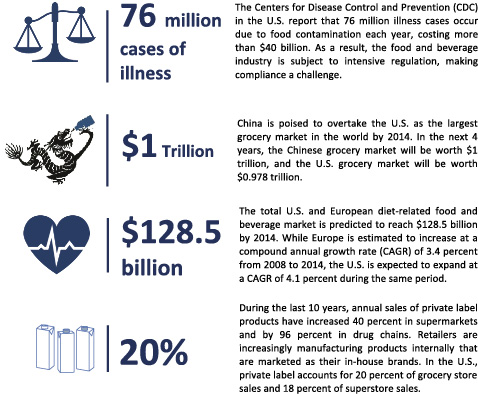The food and beverage industry, key users of pumps, is expected to be a dynamic sector during the next 5 to 10 years, based on several critical, top-level trends influencing the market. They include:

It has never been tougher to build and sustain a successful food and beverage business. Even with a recovering economy, conducting business is challenging in North America due to regulatory changes, dynamic societies and diseases, raw materials pricing, corporate sustainability goals and changing consumer demands, among others. Globally, challenges include establishing foreign operations, safety and reliability of offshore suppliers, impact of currency fluctuations and competition for talent. The list continues with a growing global population putting immense pressure on food security and supplies.
A renewed focus on healthy foods means “pure” is the new natural. Natural products are becoming the rule rather than the exception in many western markets, despite ongoing issues with a clear definition of what “natural” encompasses. This trend is also spreading to the developing regions. Increasing economic prosperity will enable the BRIC countries of Brazil, Russia, India and China, as well as Mexico, Poland and South Korea, to expand and diversify their food and beverage offerings, including nutraceutical products. Naturally-derived substances—consisting of herbal and botanical extracts and animal- and marine-based derivatives—will be the fastest growth among the major groups of nutraceutical ingredients.
While these ingredients have earned their effects as indispensable substances, they can be difficult to handle for transfer equipment, such as pumps. For example, glucose is an abrasive and fast drying substance and puts stress on the pump, leading to wearing and eventual breakdown of the pump. New products, such as nutraceuticals, may also put a strain on pumps because they are complex and time consuming when adhering to the current good manufacturing practice (CGMP) regulations.
Hygiene, convenience and flexibility play a critical role in the industry, while ensuring the highest quality. Product consistency is the key to maintaining brand equity. At the same time, keeping costs low forces operators to looking at energy costs and the efficiency of their production lines. While maintaining hygiene during food processing is important, it is also important to focus on the hygiene and sanitary implications of waste management and disposal. For example, bird or animal waste from processing is highly viscous, making pumping the material a challenge.
Market Metrics
Figure 1 shows the forecasted growth for pumps in the global food and beverage sector. This segment is expected to witness one of the highest growth rates of all pump-user segments, rivaled by the water and wastewater and pharmaceutical segments. Trends described in this article are driving strong growth in the food and beverage segment throughout the mid and long term.
Regional analysis shows that the Asia Pacific region is expected to march ahead of all the regions with double digit growth, closely followed by Latin America, then the Middle East and Africa. Increasing economic prosperity, foreign direct investments (FDIs), foreign institutional investor (FII) investments and a keen focus on government infrastructure investments, are driving growth in these regions. Pump manufacturers cannot afford to under serve these regions.
Figure 1. Pumps used in the food and beverage industry |
Fuelled by continuing economic woes, Europe is the slowest growing market, even in the mid and long term. While Western Europe continues to face financial difficulty, Eastern European countries enjoy a more optimistic economic climate and, therefore, more pump manufacturers are expanding into these regions.
North America is expected to witness a nominal growth rate (around 5 percent) through the mid and long term. While the food and beverage sector is expected to be fairly stable in North America, pump manufacturers are seeing more opportunities in maintenance and repair aspects of the value chain.
Conclusion
Driven by mega trends, the food and beverage industry is one of the fastest growing end-user segments across the globe. End-user preferences are constantly shifting, requiring pump manufacturers to be able to support end-user agility in production requirements. As North American pump manufacturers go global, they need to adapt to regional market conditions, requiring further innovations. Food and beverage is an exciting vertical segment due to expected growth rates, but innovation is a key success factor.

